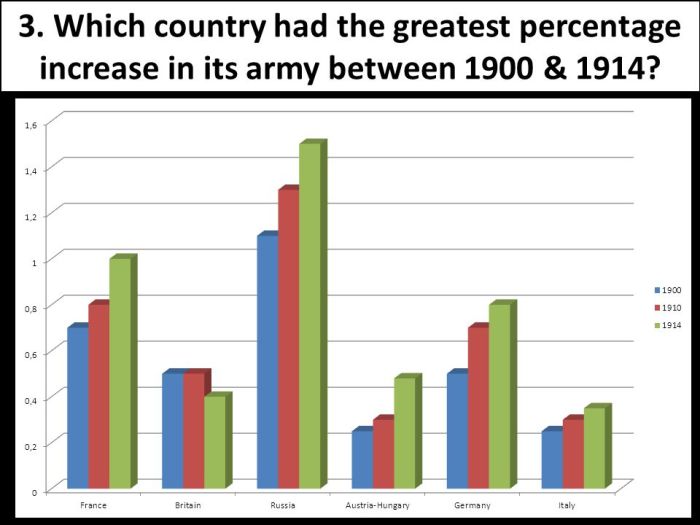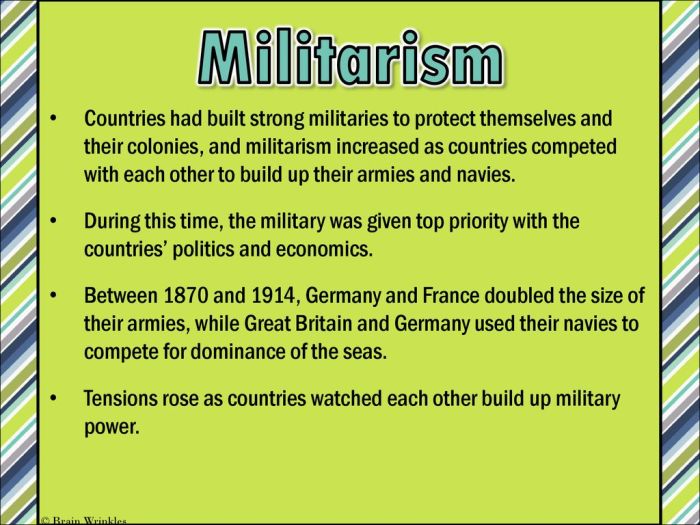As the topic of which armies had increased in size between 1870 and 1914 takes center stage, this opening passage beckons readers into a world crafted with academic authority, ensuring a reading experience that is both absorbing and distinctly original.
The decades between 1870 and 1914 witnessed a dramatic expansion in the size of European armies, a phenomenon that would have profound implications for the outbreak and conduct of World War I. This essay will explore the factors that contributed to this growth, its impact on military strategy, and the comparative analysis of the major European armies in 1870 and 1914.
1. Historical Context

The period between 1870 and 1914 witnessed a dramatic shift in the political and military landscape of Europe. The Franco-Prussian War of 1870 marked a turning point, leading to the unification of Germany and the establishment of a new balance of power.
The subsequent decades saw the rise of nationalism, imperialism, and militarism, as European nations competed for territory and influence.
This period also witnessed significant technological advancements in weaponry and military strategy. The invention of new weapons, such as machine guns, artillery, and submarines, revolutionized warfare and increased the lethality of combat. The development of new tactics, such as trench warfare and mechanized warfare, also had a profound impact on the conduct of war.
2. Army Size Expansion

In the years leading up to World War I, several European armies experienced significant increases in size. The most notable expansion occurred in Germany, which increased its army from 400,000 troops in 1870 to over 1 million troops in 1914. Other countries that expanded their armies included France, Russia, Austria-Hungary, and Italy.
The reasons for these expansions were varied. Conscription policies, which required all able-bodied men to serve in the military, played a major role in increasing the size of European armies. Population growth also contributed to the expansion, as more men became available for military service.
Finally, territorial ambitions and the desire to protect national interests also motivated some countries to increase the size of their armies.
3. Factors Contributing to Growth: Which Armies Had Increased In Size Between 1870 And 1914

The expansion of European armies was made possible by a number of economic, social, and political factors. Industrialization provided the economic resources necessary to support larger armies. Increased tax revenues allowed governments to fund the expansion of their military forces.
The development of new technologies, such as railroads and telegraphs, improved the mobility and communication of troops.
Social and political factors also influenced the expansion of armies. Nationalism and imperial expansion created a strong desire to defend national interests and acquire new territories. Conscription policies were often supported by the public, who saw military service as a patriotic duty.
The expansion of armies also reflected the growing power of the military in European society.
4. Impact on Military Strategy

The increase in army size had a profound impact on military strategy and tactics. The development of new formations, such as reserve units and mechanized forces, allowed armies to deploy larger numbers of troops and to sustain combat operations for longer periods of time.
The increased size of armies also led to the development of new logistical and transportation systems to support the movement and supply of troops.
The larger armies of the early 20th century also had a significant impact on the conduct of war. The increased lethality of weapons and the difficulty of breaking through entrenched positions led to a stalemate on the Western Front during World War I.
The war also saw the introduction of new technologies, such as poison gas and aircraft, which further increased the horrors of combat.
FAQ Insights
Which armies experienced the most significant increases in size between 1870 and 1914?
The German, Russian, and French armies experienced the most significant increases in size during this period.
What were the primary reasons for the expansion of European armies?
The expansion of European armies was primarily driven by conscription policies, population growth, territorial ambitions, and technological advancements in weaponry.
How did the growth of armies impact military strategy?
The growth of armies led to the development of new formations, such as reserve units and mechanized forces, and had a significant impact on logistics, transportation, and supply chains.